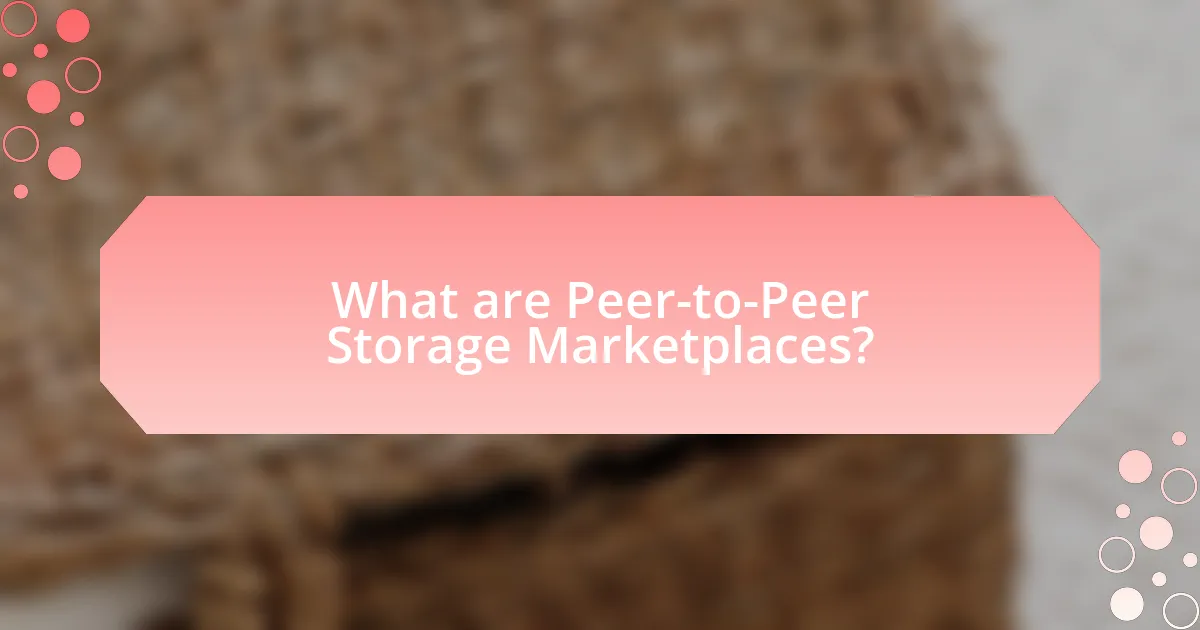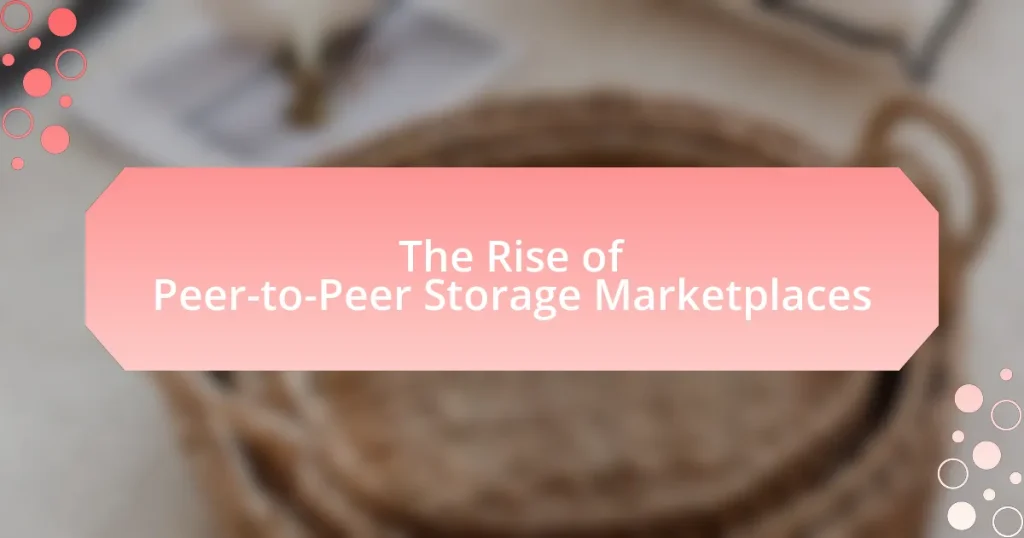Peer-to-Peer Storage Marketplaces are platforms that enable individuals to rent out their unused storage space, utilizing decentralized technologies such as blockchain to ensure secure transactions. This article explores the operational mechanisms of these marketplaces, the technologies that support them, and the benefits they offer compared to traditional storage solutions. It also addresses the challenges faced by these platforms, including trust issues and regulatory compliance, while highlighting the growing demand for decentralized storage options driven by advancements in technology and the sharing economy. Additionally, the article examines future trends, emerging markets, and best practices for users engaging with these innovative storage solutions.
What are Peer-to-Peer Storage Marketplaces?

 |
|
Peer-to-Peer Storage Marketplaces are platforms that facilitate the exchange of storage space between individuals, allowing users to rent out their unused storage capacity to others. These marketplaces leverage decentralized technology, often utilizing blockchain, to ensure secure transactions and data integrity. For example, platforms like Storj and Sia enable users to share their excess storage while earning income, thus creating a distributed network of storage resources. This model not only optimizes resource utilization but also often provides lower costs for consumers compared to traditional cloud storage solutions.
How do Peer-to-Peer Storage Marketplaces operate?
Peer-to-Peer (P2P) storage marketplaces operate by connecting individuals who have excess storage capacity with those in need of storage space. These platforms facilitate transactions between users, allowing them to rent or share storage resources directly, often through a digital interface. Users list their available storage, set prices, and manage bookings, while renters can search for and reserve storage that meets their needs. This model leverages the sharing economy, enabling efficient use of resources and often resulting in lower costs for renters compared to traditional storage solutions.
What technologies enable Peer-to-Peer Storage Marketplaces?
Blockchain technology enables Peer-to-Peer Storage Marketplaces by providing a decentralized and secure framework for transactions. This technology ensures data integrity and transparency, allowing users to store and share data without relying on a central authority. Additionally, distributed file systems, such as IPFS (InterPlanetary File System), facilitate efficient data storage and retrieval across a network of nodes, enhancing accessibility and redundancy. Smart contracts further automate agreements between users, ensuring that terms are met without the need for intermediaries. These technologies collectively create a robust ecosystem that supports the functionality and trustworthiness of Peer-to-Peer Storage Marketplaces.
How do users interact within these marketplaces?
Users interact within peer-to-peer storage marketplaces primarily through the exchange of storage space and services. These interactions typically involve users listing available storage units, browsing options, and negotiating terms directly with one another. For instance, platforms facilitate communication via messaging systems, allowing users to ask questions and finalize agreements. Additionally, users often leave reviews and ratings, which help build trust and inform future interactions. According to a report by Statista, the peer-to-peer storage market has seen significant growth, indicating a rising trend in user engagement and participation in these marketplaces.
What are the key features of Peer-to-Peer Storage Marketplaces?
Key features of Peer-to-Peer Storage Marketplaces include decentralized data storage, user-driven pricing, and enhanced privacy. Decentralized data storage allows users to store data across multiple nodes, reducing reliance on centralized servers and increasing resilience against data loss. User-driven pricing enables individuals to set their own rates for storage services, fostering competitive pricing and flexibility. Enhanced privacy is achieved through encryption and direct peer interactions, ensuring that users maintain control over their data. These features collectively contribute to a more efficient, cost-effective, and secure storage solution compared to traditional cloud services.
What types of storage options are available?
The types of storage options available include cloud storage, local storage, and peer-to-peer storage. Cloud storage allows users to store data on remote servers accessed via the internet, providing scalability and accessibility. Local storage refers to physical devices like hard drives and SSDs that store data directly on a user’s device. Peer-to-peer storage utilizes decentralized networks where users can share their unused storage space with others, enhancing efficiency and reducing costs. This model is gaining traction as it leverages existing resources and offers competitive pricing compared to traditional storage solutions.
How is data security managed in these marketplaces?
Data security in peer-to-peer storage marketplaces is managed through a combination of encryption, decentralized architecture, and user authentication protocols. These marketplaces typically employ end-to-end encryption to ensure that data is securely transmitted and stored, making it inaccessible to unauthorized users. Additionally, the decentralized nature of these platforms reduces the risk of a single point of failure, as data is distributed across multiple nodes. User authentication mechanisms, such as two-factor authentication, further enhance security by verifying the identity of users before granting access to sensitive information. This multi-layered approach effectively safeguards data against breaches and unauthorized access.
What factors have contributed to the rise of Peer-to-Peer Storage Marketplaces?
The rise of Peer-to-Peer Storage Marketplaces has been primarily driven by advancements in technology, increased demand for decentralized solutions, and the growing need for cost-effective storage options. Technological advancements, particularly in blockchain and distributed ledger technologies, have enabled secure and efficient transactions between users, fostering trust in these platforms. Additionally, the demand for decentralized solutions has surged as individuals and businesses seek alternatives to traditional cloud storage providers, which often involve centralized control and higher costs. Furthermore, the need for cost-effective storage options has prompted users to leverage underutilized resources, allowing them to monetize excess storage capacity while providing affordable services to others. These factors collectively contribute to the expanding landscape of Peer-to-Peer Storage Marketplaces.
How has the demand for storage solutions evolved?
The demand for storage solutions has significantly increased due to the exponential growth of data generation and the need for efficient data management. As of 2023, global data creation is projected to reach 175 zettabytes, driving the necessity for scalable and accessible storage options. This surge in data has led to a rise in peer-to-peer storage marketplaces, where individuals can rent out unused storage space, reflecting a shift towards decentralized storage solutions. The market for such services is expected to grow at a compound annual growth rate (CAGR) of over 30% from 2021 to 2026, indicating a robust demand for innovative storage alternatives.
What role does the sharing economy play in this rise?
The sharing economy significantly contributes to the rise of peer-to-peer storage marketplaces by facilitating the efficient use of underutilized space. This economic model allows individuals to monetize their extra storage capacity, creating a marketplace where users can rent out their unused areas, such as garages or basements, to those in need of storage solutions. According to a report by PwC, the sharing economy is projected to grow to $335 billion by 2025, indicating a robust trend towards collaborative consumption that directly benefits peer-to-peer storage platforms. This growth is driven by increased consumer acceptance of sharing services and the desire for cost-effective storage options, further validating the role of the sharing economy in this market expansion.
How do Peer-to-Peer Storage Marketplaces compare to traditional storage solutions?
Peer-to-Peer (P2P) storage marketplaces offer a decentralized alternative to traditional storage solutions, enabling users to rent out unused storage space directly to others. This model often results in lower costs for consumers, as P2P platforms can operate with reduced overhead compared to centralized providers, which typically require significant infrastructure investments. For instance, a study by the International Data Corporation (IDC) indicates that P2P storage can reduce costs by up to 50% compared to traditional cloud storage services. Additionally, P2P marketplaces enhance flexibility and scalability, allowing users to quickly adjust their storage needs based on demand, unlike traditional solutions that may involve lengthy contracts and fixed capacities.
What challenges do Peer-to-Peer Storage Marketplaces face?
Peer-to-Peer Storage Marketplaces face significant challenges including trust issues, regulatory compliance, and data security concerns. Trust issues arise because users must rely on unknown peers for storage, which can lead to skepticism about data safety and reliability. Regulatory compliance is complicated by varying laws across jurisdictions, making it difficult for these platforms to operate legally and consistently. Data security concerns stem from the potential for unauthorized access or data breaches, as users may be hesitant to store sensitive information on decentralized networks. These challenges hinder the growth and adoption of Peer-to-Peer Storage Marketplaces, as evidenced by studies indicating that user trust and security are critical factors influencing participation in such platforms.
How do regulatory issues impact these marketplaces?
Regulatory issues significantly impact peer-to-peer storage marketplaces by influencing operational compliance, user trust, and market accessibility. These marketplaces must adhere to local laws regarding data privacy, consumer protection, and liability, which can vary widely across jurisdictions. For instance, regulations like the General Data Protection Regulation (GDPR) in Europe impose strict requirements on how user data is handled, affecting how these platforms operate and manage user information. Non-compliance can lead to hefty fines and legal repercussions, which can deter marketplace participation and reduce user confidence. Additionally, regulatory frameworks can either facilitate or hinder market entry for new players, shaping the competitive landscape and innovation within the sector.
What are the common concerns regarding user trust and reliability?
Common concerns regarding user trust and reliability in peer-to-peer storage marketplaces include data security, privacy, and the credibility of service providers. Users often worry about the potential for data breaches, where sensitive information could be accessed by unauthorized parties, undermining their trust in the platform. Additionally, privacy concerns arise from the possibility of personal data being misused or inadequately protected. The reliability of service providers is also a significant issue, as users need assurance that their data will be stored safely and that the service will be consistently available. Research indicates that 60% of users express concerns about the security of their data in peer-to-peer systems, highlighting the importance of robust security measures and transparent policies to build user trust.
What are the benefits of using Peer-to-Peer Storage Marketplaces?

 |
|
Peer-to-Peer Storage Marketplaces offer several benefits, including cost-effectiveness, increased storage options, and enhanced security. These platforms allow users to rent out unused storage space, which typically results in lower prices compared to traditional storage solutions. For instance, a study by the International Journal of Information Management found that P2P storage can reduce costs by up to 50% compared to conventional storage services. Additionally, users benefit from a diverse range of storage options, as they can choose from various locations and types of storage offered by different peers. Enhanced security is another advantage, as many P2P marketplaces utilize encryption and decentralized storage methods, reducing the risk of data breaches.
How do these marketplaces provide cost savings for users?
Peer-to-peer storage marketplaces provide cost savings for users by facilitating direct transactions between individuals, eliminating the need for intermediaries. This model reduces overhead costs associated with traditional storage solutions, allowing users to access lower prices for storage services. For instance, a study by the International Journal of Information Management found that peer-to-peer platforms can offer storage rates that are up to 50% lower than conventional storage providers due to reduced operational expenses and competitive pricing among users.
What pricing models are commonly used?
Commonly used pricing models in peer-to-peer storage marketplaces include pay-per-use, subscription-based, and tiered pricing. Pay-per-use allows users to pay only for the storage they utilize, which is beneficial for those with fluctuating storage needs. Subscription-based models charge a fixed fee for access to a certain amount of storage over a specified period, providing predictability in costs. Tiered pricing offers different levels of service at varying price points, catering to diverse user requirements and budgets. These models are designed to maximize user engagement and optimize revenue for service providers.
How does competition among providers affect pricing?
Competition among providers typically leads to lower pricing in peer-to-peer storage marketplaces. When multiple providers offer similar services, they are incentivized to reduce prices to attract customers, resulting in a more competitive market. For instance, a study by the Federal Trade Commission found that increased competition in various markets often leads to price reductions, as providers seek to differentiate themselves and gain market share. This dynamic encourages providers to optimize their pricing strategies, ultimately benefiting consumers through lower costs and improved service options.
What advantages do users gain from decentralized storage solutions?
Users gain enhanced security, privacy, and control from decentralized storage solutions. These systems distribute data across multiple nodes, reducing the risk of data breaches and unauthorized access. For instance, a study by the International Journal of Information Management highlights that decentralized storage can significantly lower the likelihood of single points of failure, making data less vulnerable to attacks. Additionally, users maintain ownership of their data, as decentralized platforms often utilize encryption and blockchain technology to ensure that only authorized individuals can access their information. This level of control and security is a key advantage over traditional centralized storage solutions.
How does decentralization enhance data availability?
Decentralization enhances data availability by distributing data across multiple nodes rather than relying on a single centralized server. This distribution reduces the risk of data loss due to server failures, as data remains accessible from various locations. For instance, in peer-to-peer storage systems, users can store and retrieve data from numerous peers, ensuring that even if some nodes go offline, the data can still be accessed from others. Research indicates that decentralized networks can improve data redundancy and resilience, as seen in blockchain technology, where data is replicated across numerous participants, making it less vulnerable to outages or attacks.
What impact does it have on data ownership and control?
The rise of peer-to-peer storage marketplaces significantly impacts data ownership and control by decentralizing data storage, allowing individuals to retain greater authority over their own data. In traditional cloud storage models, data is often controlled by centralized providers, which can lead to privacy concerns and potential data breaches. In contrast, peer-to-peer systems enable users to store data across a distributed network, reducing reliance on single entities and enhancing user autonomy. This shift empowers individuals to manage their data directly, as evidenced by platforms like Filecoin and Storj, which facilitate user-controlled data storage and retrieval.
What are the future trends in Peer-to-Peer Storage Marketplaces?

 |
|
Future trends in Peer-to-Peer Storage Marketplaces include increased decentralization, enhanced security through blockchain technology, and the rise of token-based economies. Decentralization allows users to store data across multiple nodes, reducing reliance on centralized servers and improving data redundancy. Blockchain technology enhances security by providing immutable records of transactions and user identities, which builds trust among participants. Additionally, token-based economies incentivize users to contribute storage space and bandwidth, creating a more dynamic marketplace. According to a report by MarketsandMarkets, the global decentralized storage market is projected to grow significantly, indicating a strong shift towards these trends.
How is technology evolving to support these marketplaces?
Technology is evolving to support peer-to-peer storage marketplaces through advancements in blockchain, decentralized storage solutions, and enhanced user interfaces. Blockchain technology provides secure, transparent transactions and smart contracts, ensuring trust among users without intermediaries. Decentralized storage solutions, such as IPFS (InterPlanetary File System), enable users to store and share data across a distributed network, improving reliability and reducing costs. Additionally, user interfaces are becoming more intuitive, facilitating easier access and interaction for users, which is crucial for the growth of these marketplaces. These technological advancements collectively enhance security, efficiency, and user experience in peer-to-peer storage marketplaces.
What innovations are expected in data storage technology?
Innovations expected in data storage technology include advancements in decentralized storage solutions, such as blockchain-based systems, which enhance security and reliability. These technologies allow users to store data across a network of nodes, reducing reliance on centralized servers and improving data redundancy. Additionally, developments in quantum storage and DNA data storage are anticipated to significantly increase storage density and speed, with DNA storage potentially achieving up to 215 petabytes per gram. These innovations are driven by the growing demand for scalable, secure, and efficient data management solutions in an increasingly digital world.
How might blockchain influence Peer-to-Peer Storage Marketplaces?
Blockchain can significantly influence Peer-to-Peer Storage Marketplaces by enhancing security, transparency, and trust among users. The decentralized nature of blockchain technology allows for secure data storage and retrieval without relying on a central authority, reducing the risk of data breaches. Additionally, smart contracts can automate transactions and enforce agreements, ensuring that users are compensated fairly for their storage contributions. According to a report by Deloitte, blockchain can improve data integrity and reduce fraud in digital transactions, which is crucial for the success of peer-to-peer platforms. This combination of security and efficiency can lead to increased user adoption and a more robust marketplace.
What emerging markets are likely to adopt Peer-to-Peer Storage solutions?
Emerging markets likely to adopt Peer-to-Peer Storage solutions include India, Brazil, and Southeast Asian countries. These regions exhibit rapid digital transformation, increasing internet penetration, and a growing demand for cost-effective storage solutions. For instance, India has seen a surge in smartphone usage, with over 750 million users as of 2023, creating a substantial need for decentralized storage options. Similarly, Brazil’s expanding tech ecosystem and Southeast Asia’s burgeoning startup culture further support the adoption of such innovative storage solutions.
Which regions show the highest growth potential?
The regions showing the highest growth potential in the peer-to-peer storage marketplaces are North America and Asia-Pacific. North America benefits from advanced technology infrastructure and a high adoption rate of sharing economy models, while Asia-Pacific is experiencing rapid urbanization and increasing smartphone penetration, driving demand for innovative storage solutions. According to a report by MarketsandMarkets, the peer-to-peer storage market is projected to grow significantly in these regions, with North America expected to dominate due to its established market players and investment in technology.
What industries are expected to benefit most from these solutions?
The industries expected to benefit most from peer-to-peer storage marketplaces include logistics, e-commerce, and real estate. Logistics companies can utilize decentralized storage solutions to optimize inventory management and reduce costs associated with warehousing. E-commerce platforms can leverage these marketplaces to enhance their fulfillment capabilities, allowing for faster delivery times and reduced shipping expenses. Real estate firms can benefit by utilizing peer-to-peer storage for short-term rental solutions, maximizing space utilization and generating additional revenue streams. These benefits are supported by the growing trend of sharing economy models, which have shown significant cost savings and efficiency improvements across these sectors.
What best practices should users follow when engaging with Peer-to-Peer Storage Marketplaces?
Users engaging with Peer-to-Peer Storage Marketplaces should prioritize security, transparency, and user reviews. Security involves using strong passwords and enabling two-factor authentication to protect accounts. Transparency is essential; users should clearly communicate their storage needs and terms to avoid misunderstandings. Additionally, reviewing feedback from previous users helps assess the reliability of storage providers, as platforms often feature ratings and comments that reflect past experiences. Following these best practices enhances user safety and satisfaction in Peer-to-Peer Storage Marketplaces.


